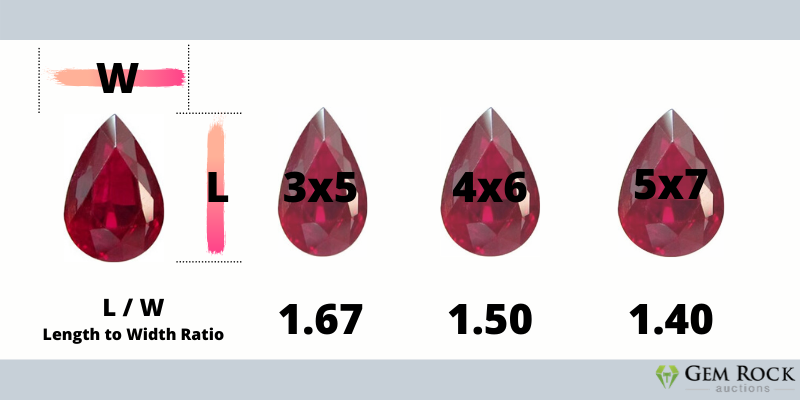
公開日11th Mar 2020
変更日時4th Jun 2025
宝石のカットにおける L/W 比とは何か、どのように使用するのか?
 宝石のカットという刺激的な世界では、「L/W」という用語がよく使われています。何かを測ったことがある人なら、この用語に馴染みがあるはずです。では、L/W比とはどういう意味でしょうか?そして、宝石カット職人はどのようにそれを使用しているのでしょうか?
宝石のカットという刺激的な世界では、「L/W」という用語がよく使われています。何かを測ったことがある人なら、この用語に馴染みがあるはずです。では、L/W比とはどういう意味でしょうか?そして、宝石カット職人はどのようにそれを使用しているのでしょうか?この記事では、要点を詳しく説明するだけでなく、L/W 比を使用して各カットを最適化する方法に関する技術的なヒントも紹介します。
このファセットカット(そして魅惑的な!)技法に挑戦してみませんか?宝石カットにおけるL/W比について知っておくべきことをすべてご紹介します。
L/Wとは何ですか?
ご想像の通り、L/Wは「長さ対幅」の略語です。宝石のカットの世界以外でも、あらゆる分野の人々が、デザイン要素から窓装飾、工業建築の設計図、数式の計算まで、あらゆるものの測定にL/Wの測定値を利用しています。想像力を働かせれば、私たちの周りの世界は基本的に長さ対幅の測定値で構成されていることに気づくでしょう。宝石研磨師 (ラピダリーとも呼ばれる) は、L/W を使用して、次のことに必要な正確な数学的比率を計算します。
- カットパターン
- カスタム宝石デザインを作成する
- 宝石の測定
L/W 比とは何ですか?
「L/W」は長さと幅の比を意味しますが、L/W比は宝石を一般的なデザインにカットするために必要な実際の数値です。宝石をカットするためのL/W比を計算するには、原石の長さと幅をミリメートル単位で測定する必要があります。これらの測定値がわかれば、計算式は簡単です。- まず、宝石の長さを幅で割ります
- これで完了です!
例えば、宝石の長さが8mm、幅が6mmだとします。8を6で割ると1.33になります。これで長さ/幅比が求められます。では、この比率を使って何ができるでしょうか?素晴らしい質問ですね!
L/W比でカットする宝石を選ぶ
宝石のL/W比を知ることは、カット職人がどのようなカットをするのかを概念化するのに役立ちます。L/W比は、大きくて粗い標本をカットする際に使われると考えるかもしれませんが、必ずしもそうではありません。より一般的には、作成したい宝石のL/W比に基づいて宝石のデザインを選択します。L/W 比に応じて宝石のデザインを選択するための役立つガイドラインを以下に示します。
- 標準的なL/W比を持つデザインを選択する
- 常にL/W比よりも小さい比率のデザインを選択してください
- または、原石と同じ長さ/幅比のデザインを選択してください
こう考えてみてください。L /W比を小さくするために余分な材料を切り詰めることはいつでもできますが、比率に合わせて材料を追加することはできません。分かりますか?
もちろん、指標は宝石自体と同じくらい多岐にわたるため、標準的なL/W比と非標準的なL/W比を理解しておくことは役に立ちます。革新的なデザインを創造する時も、一般的なデザインを扱う時も、L/W比と非標準的なL/W比の両方を扱うことになるでしょう。
最も標準的なL/W比
宝石のデザインに取り組む際、これらの指標は標準的なL/W比と一致していることに気づくでしょう。もし一致しない場合は、非標準的なデザインを作成する必要があります。これについては後ほど詳しく説明します。それぞれの測定の目的を念頭に置いてください。- 前述のように、比率は宝石の長さを幅で割ったものを指定します。
- 幅は宝石の長さをその比率で割ったものを指します。
- 長さは宝石の幅にその比率を掛けたものに等しくなります。
標準的な縦横比は、オーバルと長方形、マーキスと洋ナシの3つのカテゴリーに分けられます。それぞれ見ていきましょう!
楕円形と長方形
宝石店やジュエリーショップを訪れたことがある方なら、長方形や楕円形の宝石がどれほど人気があるのかをご存知でしょう。そのため、標準的な縦横比(L/W)について知っておくと良いでしょう。- 3×5 = 1.67
- 4×6 = 1.50
- 5×7 = 1.40
- 6×8 = 1.33
- 7×9 = 1.29
- 8×10 = 1.25
- 10×14 = 1.40
- 12×16 = 1.33

侯爵夫人
もう一つ人気の宝石カットは、エレガントなマーキスシェイプです。このカットは、オーバル、レクタングル、ペアシェイプよりも縦横比が小さく、一般的にその独特な形状から、縦横比は3x5という例外を除き、ほとんどのカットで同じです。- 2×4 = 2.0
- 2.5×5 = 2.0
- 3×5 = 1.67
- 3×6 = 2.0
- 4x8 = 2.0
- 5×10 = 2.0
- 6×12 = 2.0
- 7x14 = 2.0

梨
ペアシェイプの宝石を嫌いな人なんていませんよね?まずは長さ/幅の比率を1石から始めるのがベストですが、長さ/幅の比率を使えばペアシェイプの宝石も簡単に作れます。ペアシェイプカットの宝石の標準的な比率は以下の通りです。- 3×5 = 1.67
- 4×6 = 1.50
- 5×7 = 1.40
- 5×8 = 1.60
- 6×9 = 1.50
- 7×10 = 1.43

非標準比率の場合はどうでしょうか?
ありがとうございます!標準的なL/W比とは異なり、標準以外のL/W比の場合はセッティングをカスタマイズする必要があります。これは、標準的なL/W比が、最も人気のある宝石のカットとセッティングをすべて網羅しているからです。つまり、標準的なL/W比であれば、ほとんどの宝石職人やデザイナーが、あなたの宝石を留めるためのセッティングを常に準備していると言えるでしょう。それでも、標準的でない長さ/幅の比率の宝石には大きな需要があり、それは完全にオリジナルで唯一無二のものを求める人々にとって大きな魅力です。初期作業には多少の手間がかかりますが、最終的には他に類を見ない宝石が生まれることを覚えておいてください!
ファセットラフのショップ
Gemstone Encyclopedia検索
関連オークション
最新記事
レインボーラティスサンストーンは、様々な内包物によって3つのゴージャスな光学的効果を持つ長石の一種です。燃えるように鮮やかな色合いと格子模様が、コレクターにとって希少な宝石となっています。
12th Jan 2026
チューライトは、ゾイサイト鉱物ファミリーに属する、鮮やかなバラ色の色合いを示す希少なノルウェー産の宝石で、ジュエリーのセッティングやペンダントによく使用されます。
6th Jan 2026
記事のカテゴリ
How To's is where you will find helpful articles from gem Rock Auctions on how to cut gemstones, select gemstones and buy gemstones.
9記事数








